The general view at Manchester City is that a squad needs a minimum of seven senior defenders. After failing to bring in a senior left-back target, ultimately signing talented yet relatively inexperienced left-back Sergio Gómez from RSC Anderlecht, City still fell one short of their seven defender plan.
With injuries to Nathan Aké and Aymeric Laporte leaving the Premier League champions lacking in depth, they had to bring in another centre-back to prevent their troubles at the end of last season from returning. Identifying a defender with international experience that was for sale without being too expensive, yet capable of appearing in approximately 20 games, was the challenge for City’s recruitment team late in the transfer window. Manuel Akanji is believed to tick those boxes.
Arriving from German giants Borussia Dortmund for a reported fee of £15m, Akanji is no stranger to the big stage. With over 40 caps for the Swiss national team, the centre-back was essential to their overperformance at Euro 2020 and qualification for the upcoming 2022 FIFA World Cup. At club level, he is a starter in big games and Champions League fixtures with Dortmund and former club FC Basel, with his performances in Europe at Basel earning him a January move in 2018 to Dortmund for nearly £20m. His spell with BVB may not have been as great as expected, with his occasional niggling injuries and proneness to errors tarnishing his contribution to the team.
This Swiss international was not short of admirers this transfer window, with his Dortmund contract set to end next summer. Both AC and Inter Milan were targeting Akanji, meanwhile, Leicester City were heavily linked with him as Wesley Fofana’s replacement. With his contract situation at Dortmund and the purchases of centre-backs Nico Schlotterbeck and Niklas Süle, it was in the best interest of both club and player for Akanji to leave. He would’ve moved earlier in the window but the packages offered to Dortmund and Akanji were too cheap, with City and Akanji reportedly reaching a compromise which is higher than other clubs offered but still lower than what the defender wanted.
Nevertheless, Pep Guardiola has brought in the defensive reinforcement City needed, with this tactical analysis, in the form of a scout report, looking at the qualities Manuel Akanji will provide as defensive back-up at Manchester City.
Player profile
Manuel Akanji (187cm/6’2”, 91kg/200lbs) is a right-footed centre-back with an athletic build. The Swiss international is physically excellent, possessing strength and toughness alongside pace. His speed in recovery runs is especially effective for teams operating with a high line, such as Borussia Dortmund and Manchester City. His composure in the build-up phase paired with his passing range assists ball retention and ball progression.
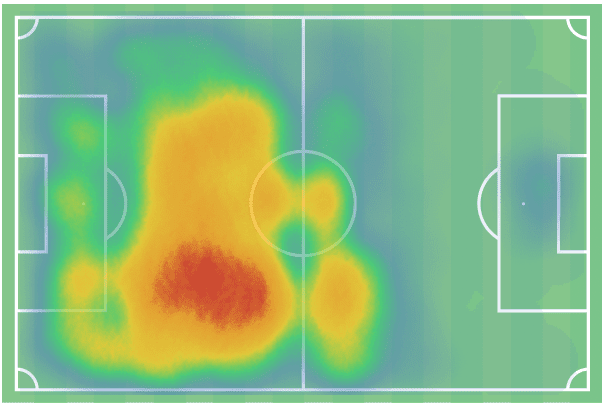
The image above displays Akanji’s heatmap from the 2021/22 season. He was typically deployed as the right-sided centre-back at Borussia Dortmund, however, he also featured on the left side and in the centre of a back three. Under manager Marco Rose last season, Dortmund lacked continuity in their shapes both in and out of possession. Frequently changing between 4-2-3-1, 4-3-3 and 4-1-2-1-2 formations, they also lined up in three-at-the-back formations to adapt to attacking absentees. Combining BVB’s lack of consistency regarding team shape and player injuries, it is clear to see why last season ended in disappointment for Dortmund.
Despite seeming to have the reputation of an injury-prone player, Akanji is rarely out for long spells. During his time at Dortmund, he experienced a few month-long injuries but nothing was greater than a month and a half out of the team, missing seven games as a result. At the age of 27, his only big injury occurred as a 21-year-old at Basel, suffering a cruciate ligament rupture. Last season, only goalkeeper Gregor Kobel, English wonderkid Jude Bellingham, and captain Marco Reus registered more minutes than Akanji’s 3,030 in all competitions.
If the Switzerland centre-back can remain fit, his versatility to play on either side of City’s centre-back pairing, as well as in the middle of a back three, will make him an extremely useful backup option. Although Akanji has made the occasional appearance at right-back throughout his career, his availability at centre-back will help ease the burden on right-back Kyle Walker, who was practically City’s third choice centre-back prior to Akanji’s arrival as a result of Laporte and Aké’s injuries.
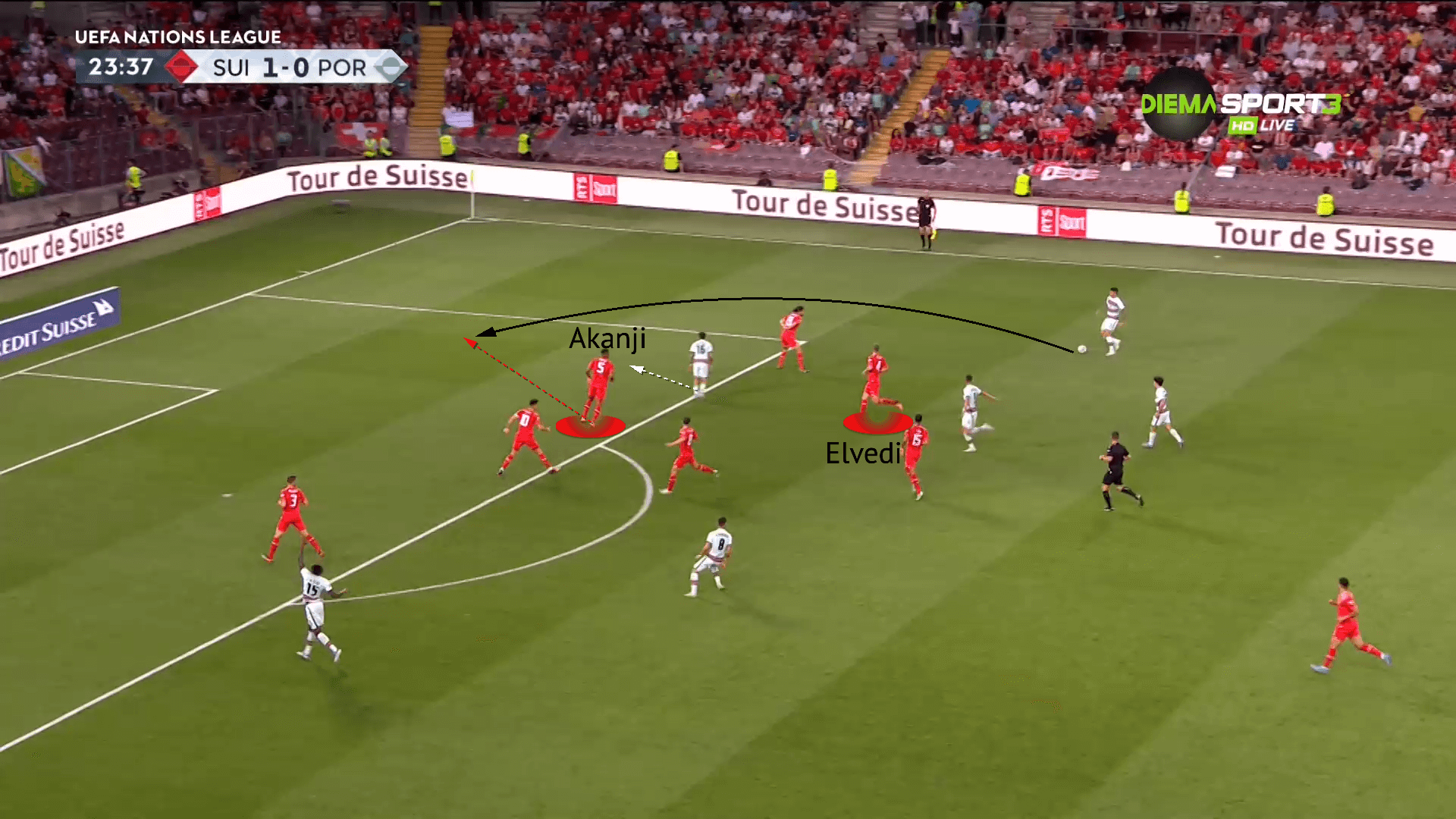
The figure above shows Akanji’s defensive awareness and versatility in the centre of the Swiss defence. With Akanji’s new teammate João Cancelo driving forwards for Portugal in transition, Akanji’s centre-back partner Nico Elvedi has been caught out of position. To prioritise ball-side compactness, Akanji has shifted across to occupy the vacant left-sided centre-back space of Elvedi, whilst communicating with Granit Xhaka to provide cover and fill in the backline. Cancelo attempts a slip pass behind the Swiss defence for Porto’s Otávio, but Akanji quickly got across and used his strength to shield the ball out for a goal kick.
With Borussia Dortmund and Manchester City’s fluidity in possession, the awareness and all-around physicality displayed above is crucial to preventing goal-scoring opportunities after a possession loss. Akanji’s ambipedal ability is also beneficial in the build-up and when defending across the backline.
In possession
Unlike in previous seasons, in the last campaign, Borussia Dortmund became much less transition-dependant and began to try and control games under manager Marco Rose. BVB ranked 2nd in the Bundesliga for average possession with 58.4% behind champions Bayern Münich. Averaging 71 passes per 90 minutes in the Bundesliga last season, Manuel Akanji registered high pass counts and experienced regular ball possession, something which he will experience at Manchester City.
As Dortmund were able to retain possession well under pressure, they would frequently face opposition that sat in a block and invited Rose’s team to try and break them down. This is similar to what Akanji will regularly face as a centre-back with City. Although centre-backs can become frustrated against low blocks and force speculative shots from distance and passes, Akanji’s familiarity in such situations should help to eliminate hasty decision-making.
In the build-up phase, Dortmund would typically shape up in a 3-3 with the full-backs providing further width outside of this structure. Akanji would be in the deepest three alongside his centre-back partner and goalkeeper Gregor Kobel, an adequate passer under pressure and an important contributor to build-up like Ederson is at City. Dortmund frequently utilised midfield rotations to progress out of the build-up phase, with these rotations particularly effective against man-oriented pressing seen in the Bundesliga. However, combination play in the wide areas is also used by BVB, as well as by the Swiss national team.
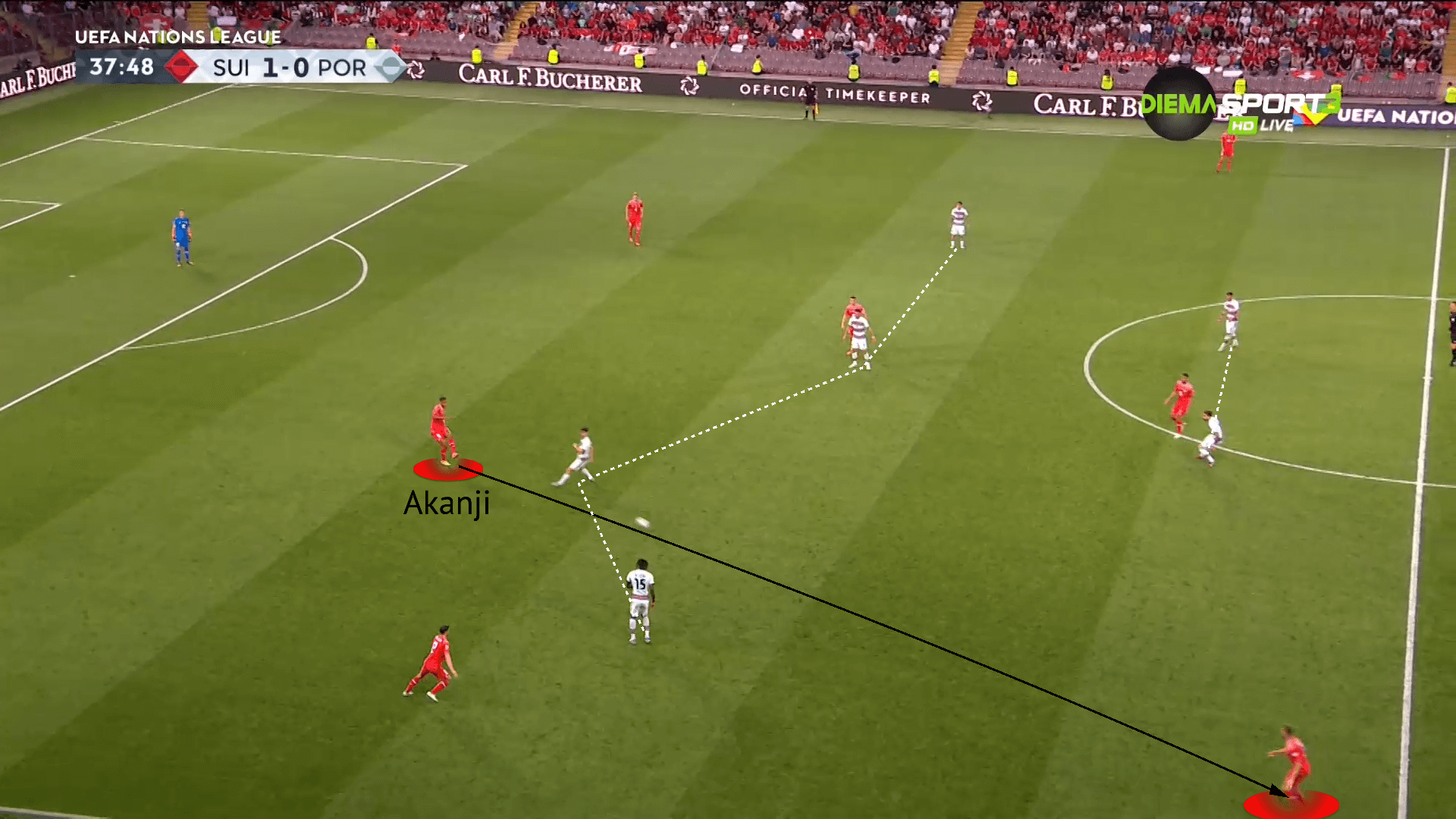
In the image above, Swiss midfielder Remo Freuler has dropped into the backline to facilitate right-back Silvan Widmer advancing. Portugal’s 4-2-4 pressing has blocked Akanji’s short passing options, but the centre-back remains calm, one of his best in possession traits. As pressure arrives from Vitinha, Widmer drops to receive a left-footed pass from Akanji to bypass the Portuguese press.
City’s new signing’s composure in possession, alongside his ambipedal passing ability, makes him an extremely tough player for opposition to press. This also allows Akanji to be forward-thinking in possession. Out of the 85 centre-backs to play over 500 minutes in the Bundesliga last season, Akanji ranked 71st for backwards passes per 90 with just 2.9. Meanwhile, the Swiss international ranked 7th for forward passes per 90 with 26.64, although he is not particularly high-risk with his passing.
Akanji offered great ball retention for Dortmund, compared to centre-back partner Mats Hummels who would attempt more direct and penetrative passes. However, last season, Akanji increased his frequency of executing longer passes, launching balls in behind the opposition defensive line for Erling Haaland and Donyell Malen’s electric off-the-ball runs.
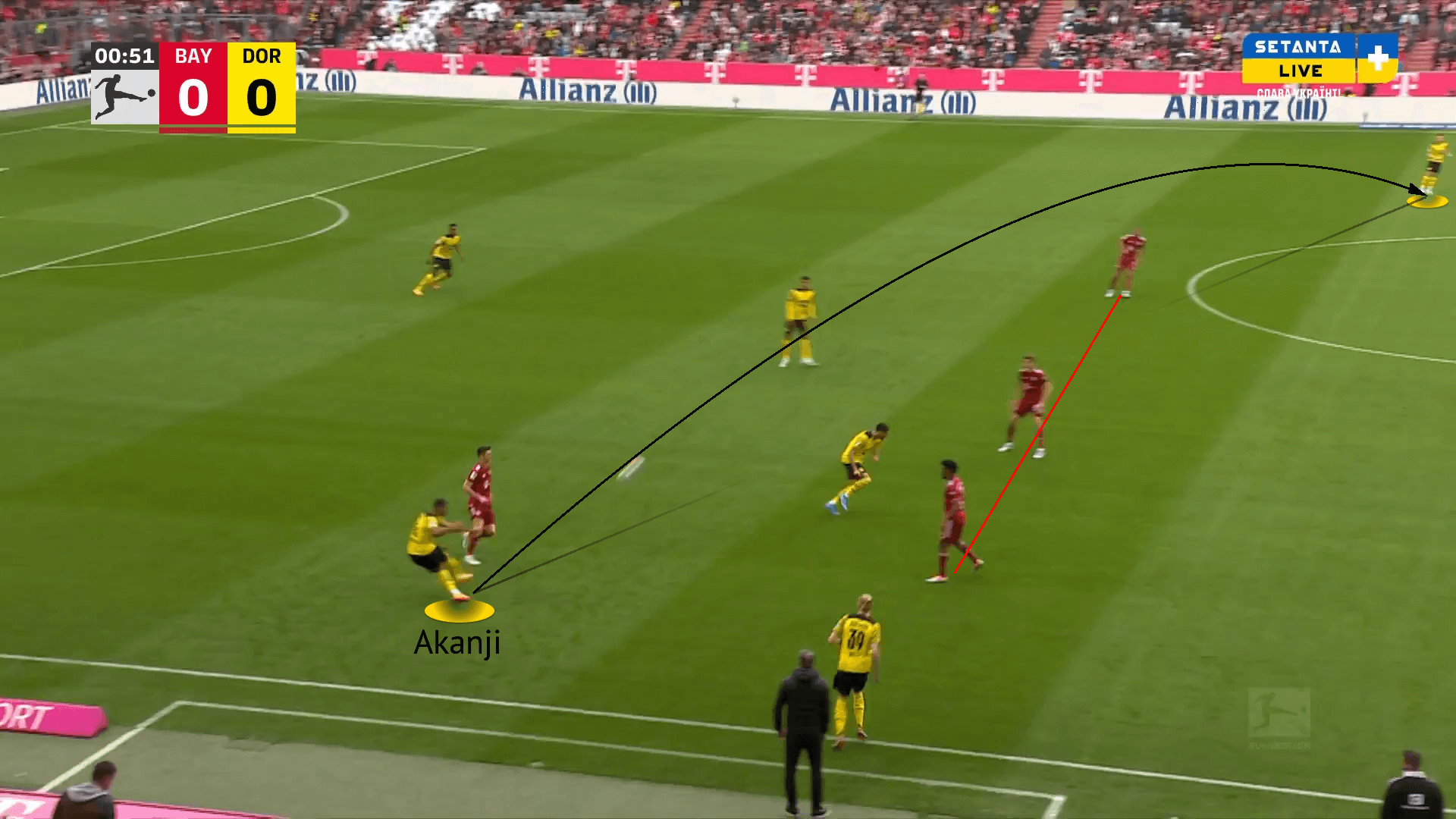
In the image above, Akanji uses his long passing to retain possession under pressure and switch play to the free man. Last season he ranked 39th out of the 85 centre-backs for long passes per 90 with 5.83, however, his average long pass length of 42.46 metres ranked 2nd.
Here, Akanji receives a throw-in from right-back Marius Wolf with the opportunity for Bayern Münich to press the centre-back against the touchline. As Bayern’s attacking midfield trio of Kingsley Coman, Thomas Müller and Serge Gnabry have narrowed and shifted across, Akanji is able to play an excellent switch of play to left-back Raphaël Guerreiro. Bypassing the press and finding the Portuguese full-back in acres of space, Dortmund were able to enter the final third.
Akanji is also able to progress the ball into the final third with direct passes himself. The Swiss international’s 8.4 passes into the final third per 90 ranked 11th out of the Bundesliga centre-backs whilst his 80.09% accuracy from these passes ranked 7th. His 11.9 progressive passes per 90 with an accuracy of 80.33% also ranked 11th and 9th respectively.
This will not particularly be his responsibility at City, with their typical 2-3-5 shape in possession generally directing the centre-back’s attention to access the holding midfielder and inverted full-backs. However, in the slightly modified 3-2-2-3 shape Guardiola deployed to come back against Crystal Palace and attempted to retake the lead against Aston Villa with at the weekend, there is more of a burden on the centre-backs to construct attacks. Akanji could cope with this increased responsibility to progress possession but not to the levels of John Stones and Aymeric Laporte, for example.
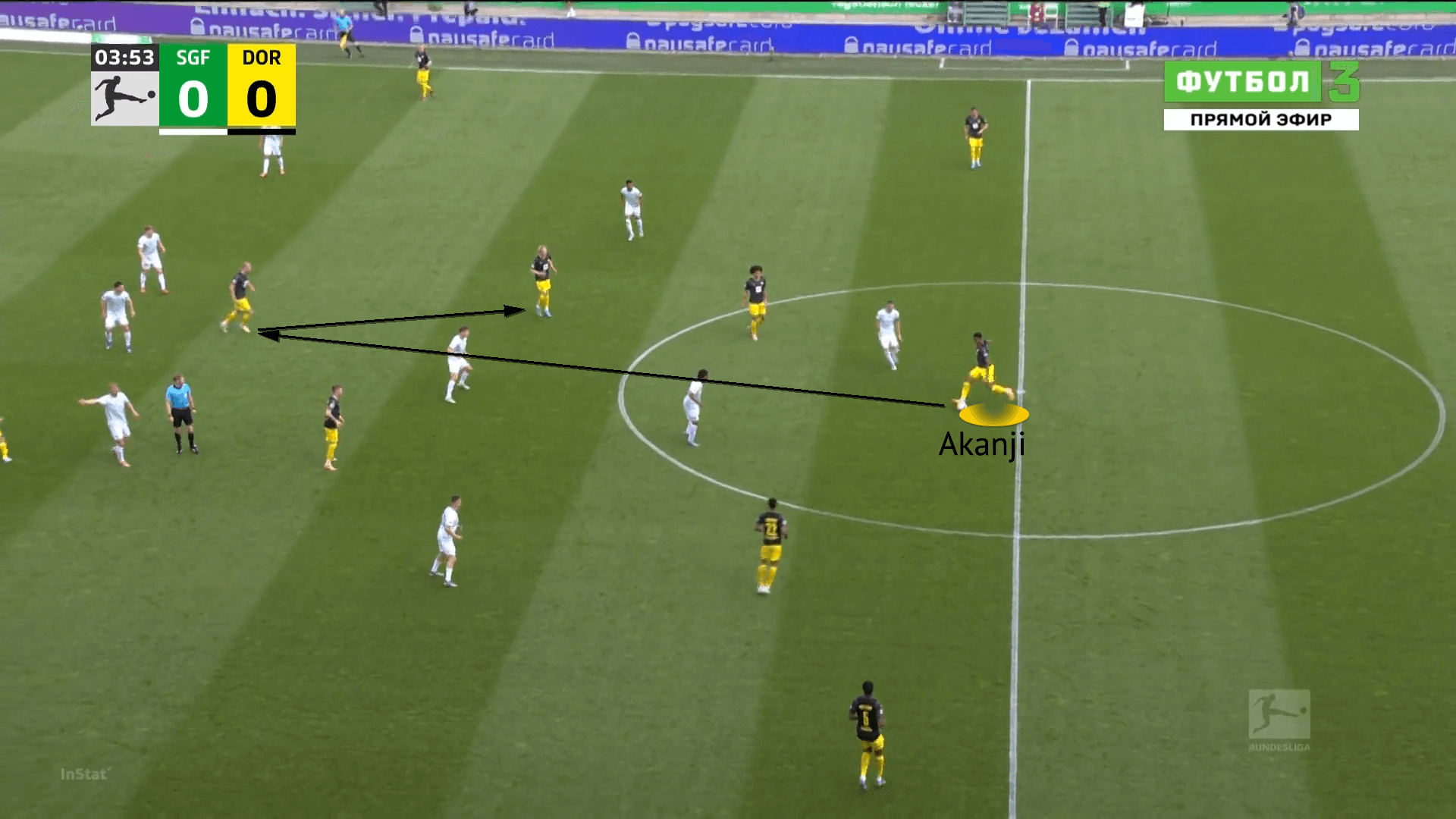
In the figure above, Akanji executes a line-breaking pass into Erling Haaland who lays the ball off to Julian Brandt. Dortmund’s shape here is also quite similar to City’s aforementioned 3-2-2-3 shape with the box midfield, as shown with Brandt and Marco Reus ahead of Axel Witsel and Jude Bellingham in the double pivot. This pass into Haaland also displays Akanji’s ambipedal passing ability. His ability to play a variety of well-weighted passes off both feet, from switches of play to disguised passes to receivers between the lines, is beneficial for Guardiola’s obsessive ball retention and progression tactics.
The continuation of Akanji’s relationship with Haaland at Manchester City will also help the Swiss international settle at his new club. The centre-back is aware of the Norwegian superstar’s habits regarding link-up play and off-the-ball movement in behind, with Haaland recommencing his role as a physically dominant outlet in England like he was in Germany with Dortmund. Akanji has also appeared alongside Sergio Gómez at Dortmund, prior to the Spaniard’s transition to left-back, and speaks multiple languages including English.
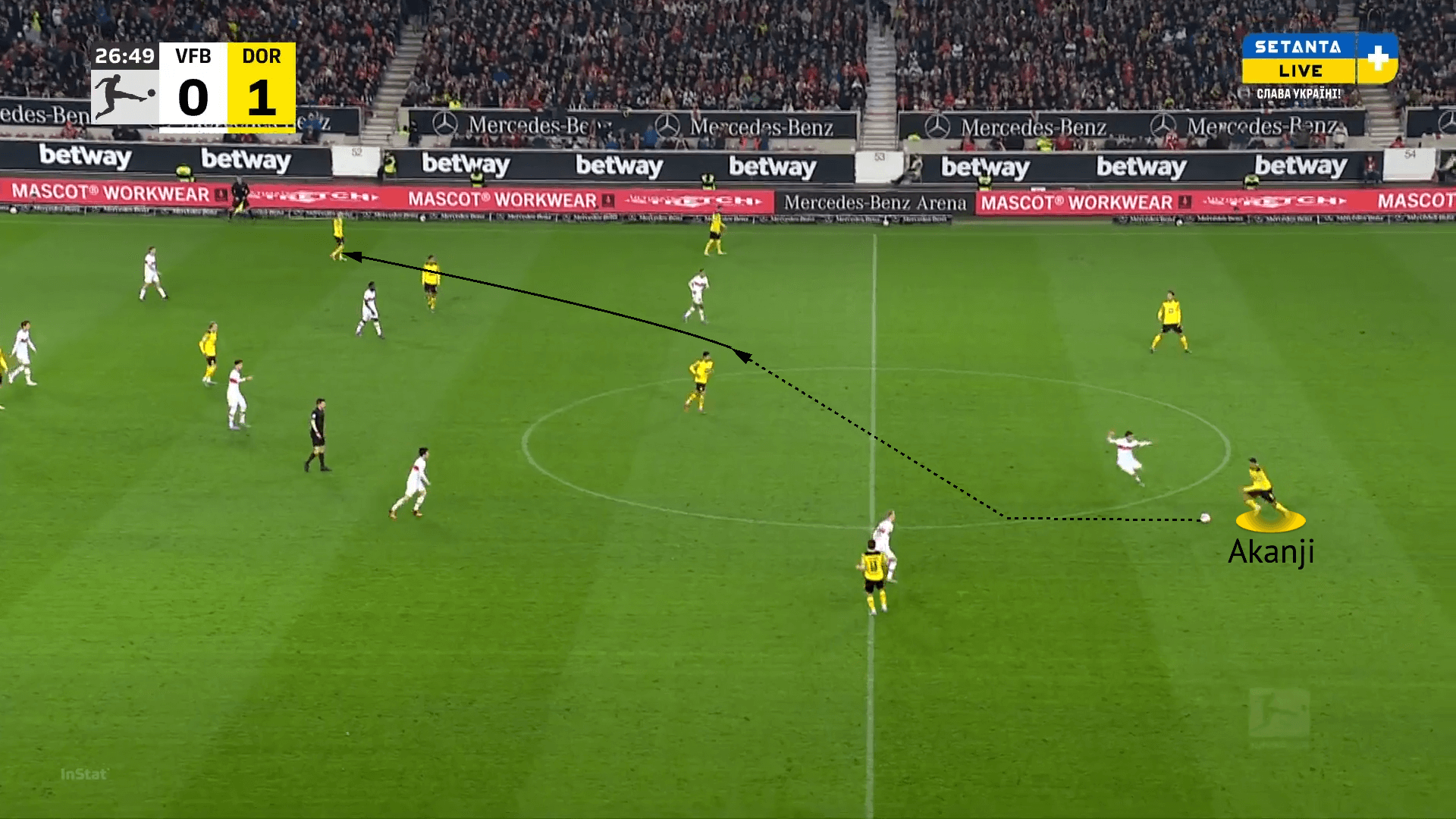
City’s new signing can also progress possession via dribbling or carrying the ball into midfield to break lines. An example of this can be seen above against VfB Stuttgart. Receiving a short, backwards pass from left-back Guerreiro, Akanji shows good ball manipulation and acceleration with his first touch and then close control to drive past Stuttgart striker Tiago Tomás. Leaving the striker behind, Akanji powers past Chris Führich, resisting pressure from Stuttgart’s right winger and shielding the ball whilst patiently waiting for the optimal moment to find Thorgan Hazard out wide. The Switzerland international ranked 16th out of the 85 Bundesliga centre-backs for progressive runs per 90 with 1.3.
Out of possession
Despite finishing 2nd in the Bundesliga last season, Borussia Dortmund conceded 52 goals, which was the 9th worst tally in the league. With such an emphasis on pressing under Marco Rose, Dortmund’s out-of-possession system could fall apart in an instant if one player was late to the press. Typically, the best pressing sides will deploy mobile midfielders and dynamic defenders to enhance counter-pressing during defensive transitions. However, Dortmund had a slow midfield and backline, with the exception of Manuel Akanji.
With the necessity of deploying a high line due to their press, Dortmund’s alarming lack of pace in the defensive line becomes noticeable. Their speed deficiency is also further highlighted by the centre-backs often being asked to man-mark opposition attackers. This has sometimes resulted in centre-backs following an attacker out of position and creating an opening for the opposition to penetrate.
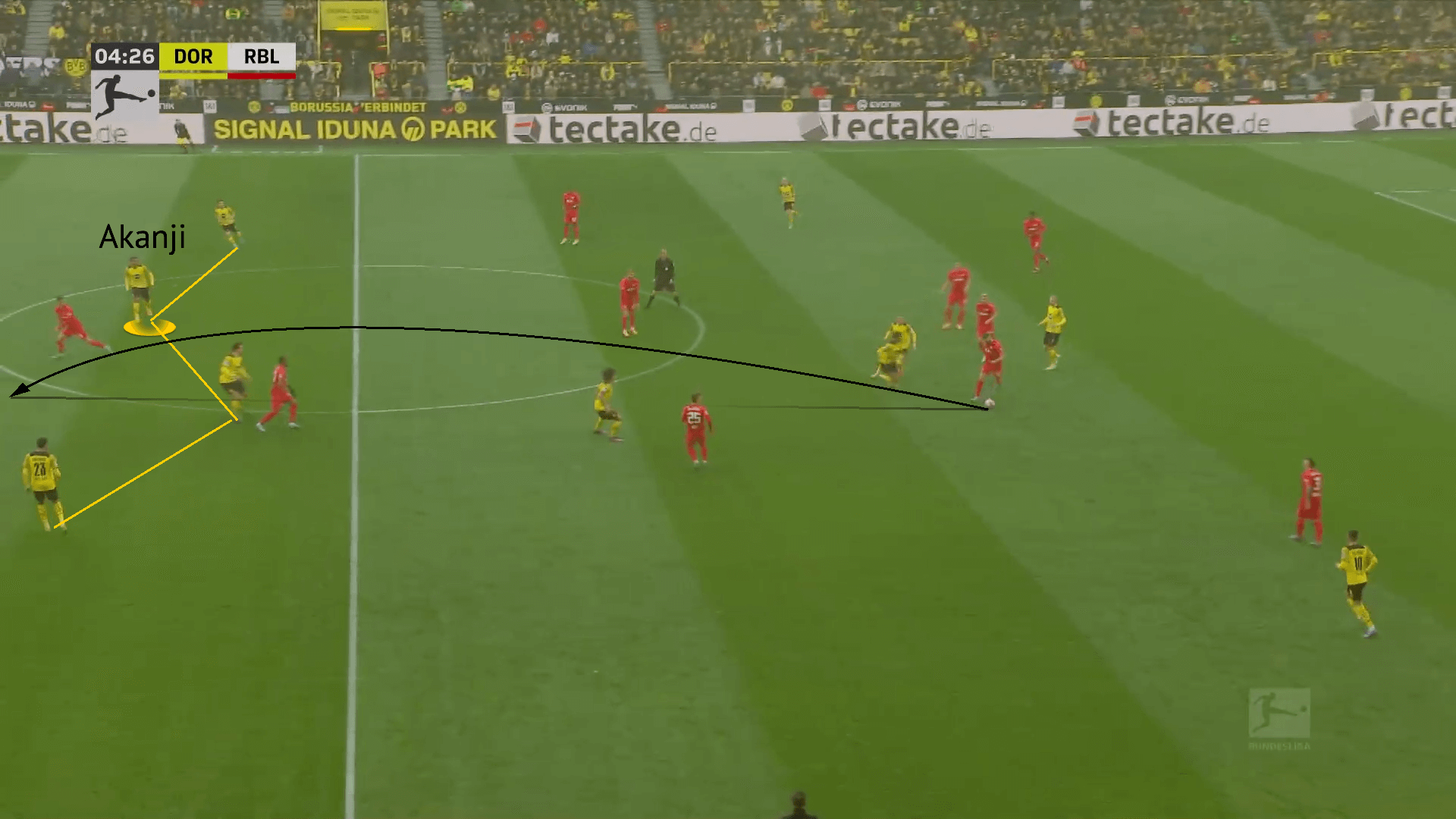
In the figure above, Akanji’s centre-back partner Mats Hummels has followed RB Leipzig’s all-round attacker Christopher Nkunku, departing the defensive line. The man-marking from the Dortmund centre-back has opened a gap for Joško Gvardiol to loft a through ball in behind and put Portuguese striker André Silva through on goal. However, as we can see, Akanji’s coolness to hold the high line and not follow André Silva’s run left the RB Leipzig striker offside.
Despite that, the infamous offside rule of linesmen keeping their flag down for goal-scoring opportunities meant that play continued with André Silva bearing down on goal. Akanji displayed phenomenal pace on the recovery run to get his leg across the striker to push the ball wide and then deflect the resulting shot to prevent what would be a disallowed goal. With Manchester City also deploying a high-line, their new signing’s familiarity and subsequent calmness and speed in such a demanding defensive strategy will be valuable for Guardiola.
Like his centre-back partners at Dortmund, Manuel Akanji is also obligated to man-mark opposition attackers. The Swiss international is an aggressive defender, exerting his superior physical force on attackers receiving with their back to goal. His aggression in rest-defence was instrumental for Dortmund’s counter-press in the opposition half, and will also help City regain possession and sustain pressure. With Dortmund dominating possession, Akanji only ranked 64th out of the 85 Bundesliga centre-backs for contested defensive duels per 90 with 6.38. However, his defensive duel win rate of 75.75% ranked 4th. There are occasions where Akanji overcommits or is overly aggressive, making him easy to roll past despite his considerable size and physicality.
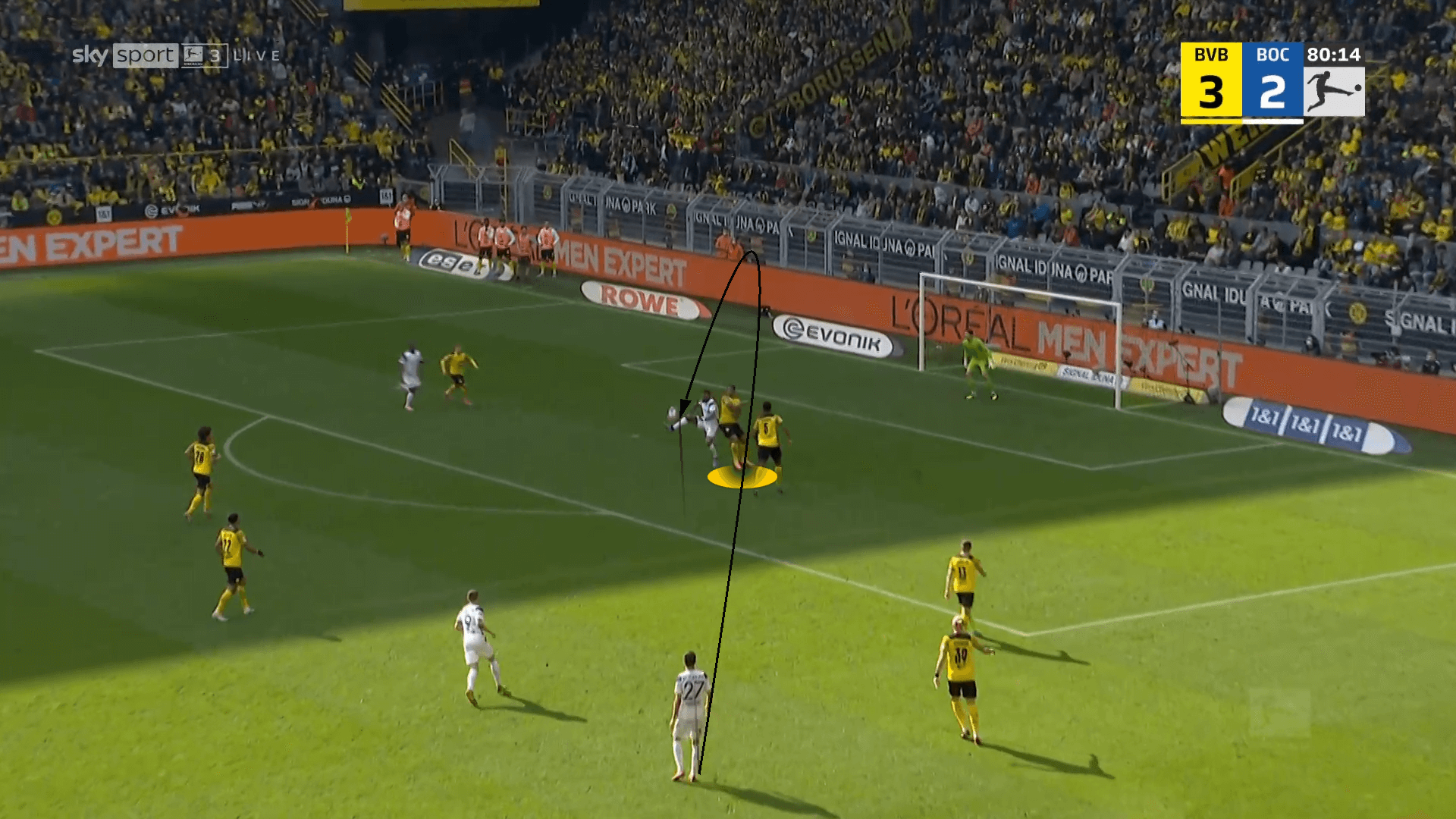
In the image above, Akanji seriously struggles to deal with the looping ball into the box. Failing to correctly read the flight of the ball and overcommitting towards Jürgen Locadia’s left shoulder, the VfL Bochum striker brings the ball down with quality control over his right shoulder to spin past Akanji and finish past Gregor Kobel.
Aerial duels are one of the weakest areas in the new City signing’s game. He has minimal influence from set-pieces and is generally unsuccessful when engaging in aerial duels. His 3.38 aerial duels per 90 ranked 61st out of the 85 Bundesliga centre-backs, and his 49.45% aerial duel success rate ranked even worse at 71st. His box defending can also be quite poor, with the occasional lapse in concentration.
He is typically unfazed by step-overs and more complex ball manipulation, but more direct dribbling can trouble the centre-back. Despite his impressive speed over long distances, inside the box Akanji can struggle to quickly move his feet and shift his weight to block shooting angles or tackle opponents. His box defending will be limited at City, due to their brilliant ball retention and expert off-the-ball work, but is still a potential area of concern for Pep Guardiola and his staff to iron out.
Conclusion
Considering the aforementioned lack of senior defensive depth at Manchester City due to injuries, the arrival of centre-back Manuel Akanji was needed. With numerous defensive absentees at decisive moments towards the end of last season resulting in players battling through whilst injured, Pep Guardiola wanted to avoid that situation from happening again. In an unprecedented campaign with the mid-season 2022 World Cup in Qatar and consequent fixture congestion, having a player of Akanji’s profile able to step in when needed will bolster City’s charge for silverware.
An influential leader in the Swiss national team, Akanjj will also be going to the World Cup. His international experience and contribution at Borussia Dortmund in the Bundesliga and the Champions League was highlighted by City. With the centre-back’s contract running out at Dortmund, the Premier League champions were able to acquire Akanji for a cut price.
Stylistically, City’s new signing has the qualities common in Guardiola centre-backs. Composed in the build-up phase with secure ball retention, aided by his ambipedal passing ability, Akanji can also progress possession through passing and dribbling. Physically superb, the Switzerland international has the excellent recovery pace and aggression needed to play in a high line. Although the 27-year-old has some issues with box defending and aerial duels, City will look to refine these flaws.
In this tactical analysis, we have looked at Manuel Akanji’s style of play, discussing his in-possession and out-of-possession attributes as a sensible acquisition for Manchester City’s defensive unit.






Comments